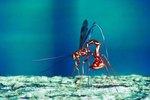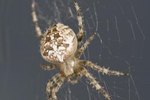The fairy fly is also known as fairy wasp or mymaridae, its official name. This tiny insect lives in temperate climates around the world. Because of the many species of fairy flu in existence, the differences within the species are many. For example, some of them are wingless, while others have extremely long antennae that are used to locate prey. No matter the species, though, the fairy fly is a very unusual and interesting insect.
The Name
Fairy flies are not flies at all. They are wasps. In fact, if you grab a microscope -- some species are really that small -- you'll see that they look more like wasps than flies. Their bodies have an elongated shape and their wings have bristles or tiny hairs on the fringes. Although they live primarily in tropical forests, fairy flies can be found in almost any part of the world with a temperate climate.
Size
The fairy fly is the tiniest of all insects. Because there are 1424 species of fairy flies, not all have the same size. However, the tiniest of them, the Alaptus fairy fly, truly is the smallest insect in existence. The Alaptus measures just 0.007 inches or 0.18 millimeters.
Social Attitude
While many insects form complicated social groups -- think of ants and bees, for example -- the fairy fly is just the opposite. Although they get together for mating, there's no courtship and no family groups among fairy flies. This makes them relatively hard to study, which is why much of their behavior is still a mystery to scientists.
Job
Well, humans have given them a job -- although they're probably not aware of it. Fireflies have been used in many areas around the world to help control pests. That's because fairy flies are parasitoids. That means the fairy fly lies eggs among the eggs of other insects -- including many pest insects. When the eggs hatch, the baby fairy flies actually feed on the other insects, helping control the population. Releasing fairy flies in areas where pests live can help control those pests. Common pests the fairy fly can help control include the booklice, flies, leafhoppers, and the alfalfa weevil.
References
Writer Bio
Tammy Dray has been writing since 1996. She specializes in health, wellness and travel topics and has credits in various publications including Woman's Day, Marie Claire, Adirondack Life and Self. She is also a seasoned independent traveler and a certified personal trainer and nutrition consultant. Dray is pursuing a criminal justice degree at Penn Foster College.





